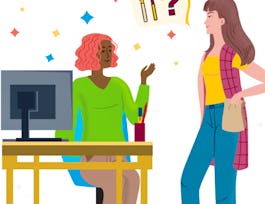Recently revised and updated! Effective teamwork and group communication are essential for your professional and personal success. In this course you will learn to: make better decisions, be more creative and innovative, manage conflict and work with difficult group members, negotiate for preferred outcomes, improve group communication in virtual environments, develop a better overall understanding of human interaction, and work more effectively as a team. Our goal is to help you understand these important dynamics of group communication and learn how to put them into practice to improve your overall teamwork.



Teamwork Skills: Communicating Effectively in Groups
This course is part of Business Communication Specialization

Instructor: Matthew A. Koschmann, PhD
Sponsored by EdgePoint Software
221,231 already enrolled
(3,355 reviews)
Recommended experience
What you'll learn
Recognize how hidden forces of context, systems, institutions, and interactions design affect group interaction
Develop decision making practices in order to become more creative and innovative
Learn how to communicate to resolve or diffuse group conflicts
Make better decisions about using technology for group work based on key practical and conceptual considerations
Skills you'll gain
Details to know

Add to your LinkedIn profile
4 assignments
See how employees at top companies are mastering in-demand skills

Build your subject-matter expertise
- Learn new concepts from industry experts
- Gain a foundational understanding of a subject or tool
- Develop job-relevant skills with hands-on projects
- Earn a shareable career certificate


Earn a career certificate
Add this credential to your LinkedIn profile, resume, or CV
Share it on social media and in your performance review

There are 4 modules in this course
Week 1 is all about communication. But not the common sense or taken-for-granted notions of communication you might expect. Instead, we’re going to rethink communication and challenge some of the conventional wisdom about communication that is common in our society. We’ll compare and contrast different theories or models of communication, and see if we can develop a more sophisticated understanding of communication to understand the complexities of human interaction in today’s groups. We’ll also explore some of the hidden forces of group communication, like context, systems and institutions, and design. These are all things that are “present” in any group situation, influencing how we interact with each other, but easy to miss if we’re not looking. We want to expand our field of vision, so to speak, so we have a fuller understanding of what’s happening in any group situation.
What's included
8 videos1 reading1 assignment2 discussion prompts1 plugin
Week 2 focuses on group development and decision making. We’ll look at how groups come together through socialization, how they develop norms, and how roles emerge. And we’ll compare and contrast different models that explain these processes. We’ll examine the various decision making traps that groups can fall into, while also developing better practices for making good group decisions. And we’ll explore how groups can be more creative and innovative in their decision making.
What's included
7 videos1 assignment1 peer review1 discussion prompt
Week 3 is all about conflict, difference, and diversity. We’ll learn how groups can have a good fight and how you can choose the right words in a dispute…as well as how to negotiate with others when things get difficult. We’ll also explore why difference and diversity are so important for group communication, and how understanding the concept of identity is critical for our involvement in groups. And we’ll pay special attention to communication and gender, one of the most significant aspects of difference and diversity for groups to understand.
What's included
7 videos1 assignment1 discussion prompt
Week 4 covers group communication and technology…an increasingly prevalent aspect of the modern landscape of group work we must understand. We’ll look at the concept of virtual work and how groups are using technology, as well as various models and theories of media functionality and information processing. We’ll cover several practical and conceptual issues we should always keep in mind when it comes to technology and group communication, and we’ll explore some cutting-edge thinking about technology and group work through the fascinating theory of sociomateriality.
What's included
7 videos1 reading1 assignment1 peer review1 discussion prompt
Instructor

Offered by
Why people choose Coursera for their career




Learner reviews
3,355 reviews
- 5 stars
80.64%
- 4 stars
14.37%
- 3 stars
2.59%
- 2 stars
0.83%
- 1 star
1.54%
Showing 3 of 3355
Reviewed on Sep 24, 2020
good content, i have learned a lot in decision making and understanding your teammates. it helped me communicate very well with my team and have come up easily with solutions to problems.
Reviewed on Apr 26, 2021
The Professor is an exceptional professor. He has a great ability to break down complex bits of information and explain them, part by part. Thank you for providing such an informative course.
Reviewed on Apr 27, 2020
Amazing course! I've learned a lot of new theories & ideas of Group Communication! in a simple yet interesting way. I will definitely make use of knowledge gain from this course in my practical life !
Recommended if you're interested in Business

University of Maryland, College Park

Arizona State University

Automatic Data Processing, Inc. (ADP)

Open new doors with Coursera Plus
Unlimited access to 10,000+ world-class courses, hands-on projects, and job-ready certificate programs - all included in your subscription
Advance your career with an online degree
Earn a degree from world-class universities - 100% online
Join over 3,400 global companies that choose Coursera for Business
Upskill your employees to excel in the digital economy



